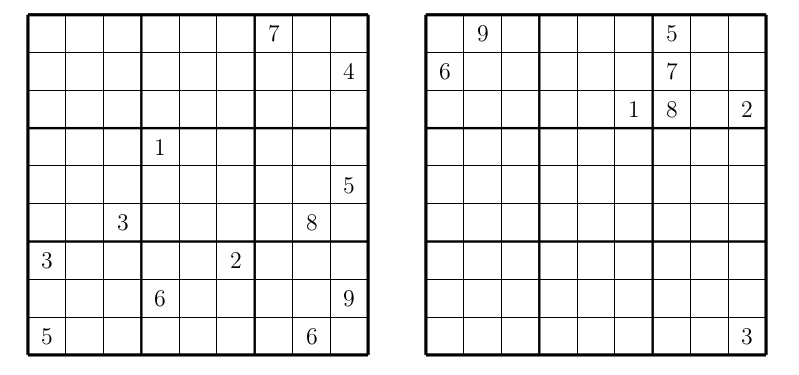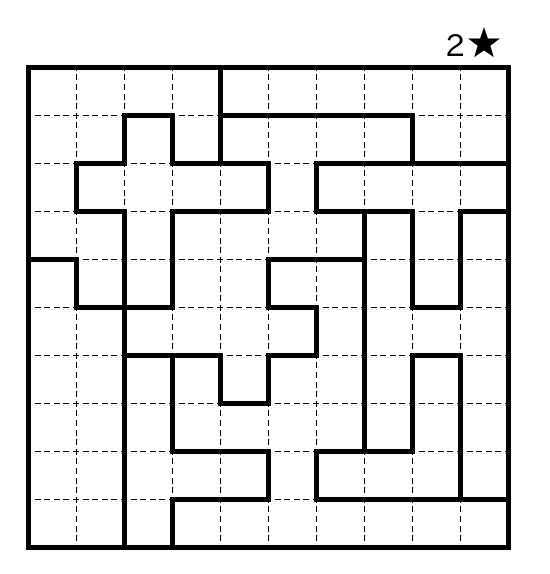Archive for the ‘Puzzles’ Category.
16th December 2021, 11:06 am
I recently wrote a post, A Splashy Math Problem, with an interesting problem from the 2021 Moscow Math Olympiad.
Problem (by Dmitry Krekov). Does there exist a number A so that for any natural number n, there exists a square of a natural number that differs from the ceiling of An by 2?
The problem is very difficult, but the solution is not long. It starts with a trick. Suppose A = t2, then An + 1/An = t2n + 1/t2n = (tn + 1/tn)2 − 2. If t < 1, then the ceiling of An differs by 2 from a square as long as tn + 1/tn is an integer. A trivial induction shows that it is enough for t + 1/t to be an integer. What is left to do is to pick a suitable quadratic equation with the first and the last term equal to 1, say x2 – 6x + 1, and declare t to be its largest root.
Share:





15th December 2021, 02:06 pm
Today I present three problems from the 41-st Tournament of the Towns that I liked: an easy one, one that reminds me of the Collatz conjecture, and a hard one.
Problem 1 (by Aleksey Voropayev). A magician places all the cards from the standard 52-card deck face up in a row. He promises that the card left at the end will be the ace of clubs. At any moment, an audience member tells a number n that doesn’t exceed the number of cards left in the row. The magician counts the nth card from the left or right and removes it. Where does the magician need to put the ace of clubs to guarantee the success of his trick?
Problem 2 (by Vladislav Novikov). Number x on the blackboard can be replaced by either 3x + 1 or ⌊x/2⌋. Prove that you can use these operations to get to any natural number when starting with 1.
Problem 3 (by A. Gribalko). There are 2n consecutive integers written on a blackboard. In one move, you can split all the numbers into pairs and replace every pair a, b with two numbers: a + b and a − b. (The numbers can be subtracted in any order, and all pairs have to be replaced simultaneously.) Prove that no 2n consecutive integers will ever appear on the board after the first move.
Share:





14th December 2021, 06:29 pm
Here is a cute old problem that Facebook recently reminded me of.
Puzzle. By mistake, a clock-maker made the hour hand and the minute hand on a clock exactly the same. How many times a day, you can’t tell the current time by looking at the clock? (It is implied that the hands move continuously, and you can pinpoint their exact location. Also, you are not allowed to watch how the hands move.)
Here is the solution by my son who was working on it together with my grandson.
The right way to think about it is to imagine a “shadow minute hand”, like this: Start at noon. As the true hour hand advances, the minute hand advances 12 times faster. If the true minute hand were the hour hand, there would have to be a minute hand somewhere; call that position the shadow minute hand. The shadow minute hand advances 12 times faster than the true minute hand. The situations that are potentially ambiguous are the ones where the shadow minute hand coincides with the hour hand. Since the former makes 144 circuits while the latter makes 1, they coincide 143 times. However, of those, 11 are positions where the true minute hand is also in the same place, so you can still tell the time after all. So there are 132 times where the time is ambiguous during the 12-hour period, which leads to the answer: 268.
I love the problem and gave it to my students; but, accidentally, I used CAN instead of CAN’T:
Puzzle. By mistake, a clock-maker made the hour hand and the minute hand on a clock exactly the same. How many times a day can you tell the current time by looking at the clock?
Obviously, the answer is infinitely many times. However, almost all of the students submitted the same wrong finite answer. Can you guess what it was? And can you explain to me why?
Share:





11th December 2021, 02:36 pm
5th December 2021, 11:03 am
A cute puzzle found on Facebook:
Puzzle. Four wizards A, B, C, and D, were given three cards each. They were told that the cards had numbers from 1 to 12 written without repeats. The wizards only knew their own three numbers and had the following exchange.
- A: “I have number 8 on one of my cards.”
- B: “All my numbers are prime.”
- C: “All my numbers are composite. Moreover, they all have a common prime factor.”
- D: “Then I know the cards of each of you.”
Given that every wizard told the truth, what cards does A have?
Share:





19th September 2021, 05:30 pm
My students (Matvey Borodin, Eric Chen, Aidan Duncan, Boyan Litchev, Jiahe Liu, Veronika Moroz, Matthew Qian, Rohith Raghavan, Garima Rastogi, Michael Voigt) and I recently wrote a paper connecting the stable marriage problem and Sudoku. I just blogged about it. By the way, my students are in grades 7-9.
On the way, we invented a new type of Sudoku, which we call joint-groups Sudoku. This type is in contrast to a famous type of Sudoku, called disjoint-groups Sudoku. In a disjoint-groups Sudoku, in a particular place in a 3 by 3 box, all the digits are distinct across all the boxes. For example, the top-left corners of nine boxes have all the digits 1 thought 9. This creates nine additional disconnected regions (depending on the placements inside a 3 by 3 box) to add to columns, rows, and boxes that have to contain distinct digits.
For our new type, we wanted the digits in a particular place in each box, instead of being different, to be the same as much as possible. How much of sameness is possible? The first row contains three top-left corners. Thus, by Sudoku rules, these top-left corners have to be distinct. Thus, the top-left corners in all nine boxes have to contain at least three distinct digits. So here is the rule for the joint-groups Sudoku: the nine digits in a particular place in a 3 by 3 box contain not more than three distinct digits. It is easy to see that it means they contain exactly 3 distinct digits, each of them three times.
Here are two Sudoku puzzles from our paper. Each puzzle, when completed, forms a joint-groups Sudoku.
Share:





20th August 2021, 04:38 pm
I recently posted my puzzle designed for the MoMath meet-up.
What’s in the Name?
- 4, 6, X, 9, 10, 12, 14, 15, 16
- 1, 2, 6, 24, 120, X, 5040, 40320, 362880
- 2, X, 3, 4, 7
- 1, 2, 3, 4, 5, 6, X, 8, 9, 153, 370, 371
- X, 2, 3, 4, 5, 6, 7
- 6, 28, 496, 8128, X, 8589869056, 137438691328
- 0, 1, 1, X, 4, 7, 13, 24, 44, 81
Now it is time for the solution.
The solvers might recognize some sequences and numbers. For example, numbers 6, 28, and 496 are famous perfect numbers. Otherwise, the solvers are expected to Google the numbers and the pieces of the sequences with or without X. The best resource for finding the sequences is the Online Encyclopedia of Integer Sequence.
The first “AHA!” happens when the solvers notice that the sequences’ names are in alphabetical order. The order serves as a confirmation of the correctness of the names. It also helps in figuring out the rest of the sequences’ names. The alphabetical order in such types of puzzles hints that the real order is hidden somewhere else. It also emphasizes that the names might be important. The sequences names in order are:
- Composite
- Factorial
- Lucas
- Narcissistic
- Natural
- Perfect
- Tribonacci
The second “AHA!” moment happens when the solvers realize that the Xs all have different indices. The indices serve as the final order, which in this case is the following:
- Natural
- Lucas
- Composite
- Tribonacci
- Perfect
- Factorial
- Narcissistic
The third “AHA!” moment happens when the solvers realize that the number of terms is different in different sequences. It would have been easy to make the number of terms the same. This means that the number of terms has some significance. In fact, the number of terms in each sequence matches the length of the name of the sequence. The solvers then can pick the letter from each of the names corresponding to X. When placed in order, the answer reads: NUMBERS.
The answer is related to the puzzle in two ways:
- The puzzle is about numbers.
- The sequences’ names do actually need the second word: Lucas numbers, composite numbers, and so on.
The advantage of this puzzle for zoomed group events is that the big part of the job — figuring out the sequences — is parallelizable. Additionally, it has three “AHA!” moments, which means different people can contribute to a breakthrough. The puzzle also has some redundancy in it:
- Due to the redundancy of the English language, it is possible to solve this puzzle without figuring out the names of all the sequences.
- If the solvers can’t figure out the order, they can anagram the letters to get to the answer.
- If the solvers do not realize that they have to use the letter indexed by the X, there is another way to see the answer: read the diagonal when the sequences’ names are in order.
Share:





9th August 2021, 01:24 pm
- 4, 6, X, 9, 10, 12, 14, 15, 16
- 1, 2, 6, 24, 120, X, 5040, 40320, 362880
- 2, X, 3, 4, 7
- 1, 2, 3, 4, 5, 6, X, 8, 9, 153, 370, 371
- X, 2, 3, 4, 5, 6, 7
- 6, 28, 496, 8128, X, 8589869056, 137438691328
- 0, 1, 1, X, 4, 7, 13, 24, 44, 81
This is the puzzle I designed for yesterday’s event at the Museum of Mathematics. This puzzle is without instructions — figuring out what needs to be done is part of the fun. Solvers are allowed to use the Internet and any available tools. The answer to this puzzle is a word.
Share:






